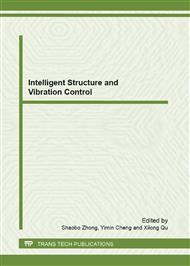[1]
Xie Xu. Seismic response and earthquake resistant design of bridges. China Communications Press , Beijing(2006).
Google Scholar
[2]
M. Liu and D.G. Gorman. Formulation of Rayleigh Damping and its extensions. Computer and Structures, Vol. 57(1995), No. 2, pp.277-285.
DOI: 10.1016/0045-7949(94)00611-6
Google Scholar
[3]
Yoshikazu Yamada and Kenji Kawano. Dynamic response analysis of systems with non-proportional damping. Proceedings of the 4th Japan Earthquake Engineering Symposium. Tokyo(1975), pp.823-830.
Google Scholar
[4]
Lord Rayleigh. Theory of Sound. Dover Publications Inc., New York, N.Y. (1945), Vol. 1.
Google Scholar
[5]
T.K. Caughey. Classical normal modes in damped linear dynamic systems. Journal of Applied Mechanics, June, (1960), pp.269-271.
DOI: 10.1115/1.3643949
Google Scholar
[6]
T.K. Caughey,M. E. J. O'Kelly. Classical normal modes in damped linear dynamic systems. Journal of Applied Mechanics, September, (1965) , pp.583-588.
DOI: 10.1115/1.3627262
Google Scholar
[7]
K.A. Foss. Co-ordinates which uncouple the equations of motion of damped linear dynamic systems. Journal of Applied Mechanics, September, (1958), pp.361-364.
DOI: 10.1115/1.4011828
Google Scholar
[8]
D.L. Cronin. Eigenvalue and eigenvector determination for nonclassically damped dynamic systems. Computers & Structure. Vol. 36(1990), No. 1, pp.133-138.
DOI: 10.1016/0045-7949(90)90182-2
Google Scholar
[9]
BU Zhan-Yu. Cable-deck Coupled Vibration and Damping Characteristic Research in the Seismic Response Analysis of Cable-stayed Bridges. Doctor thesis of Zhejiang University (2005).
Google Scholar
[10]
R.M. Lin, J. Zhu. On the relationship between viscous and hysteretic damping models and the importance of correct interpretation for system identification. Journal of Sound and Vibration, 325 (2009): 14–33.
DOI: 10.1016/j.jsv.2009.02.051
Google Scholar
[11]
S. Yoshiyuki, H. Nobuyuki, M. Tomoji, A. Masatake. Erection of Tatara Bridge,. IHI Engineering Review, Vol. 36, No. 2(2003): pp.65-84.
Google Scholar
[12]
Y. Manabe, H. Yamaguchi, N. Sasaki. Field vibration test of the Tatara bridge. Bridge and Foundation Engineering , No. 5 (1999): pp.27-30.
Google Scholar


